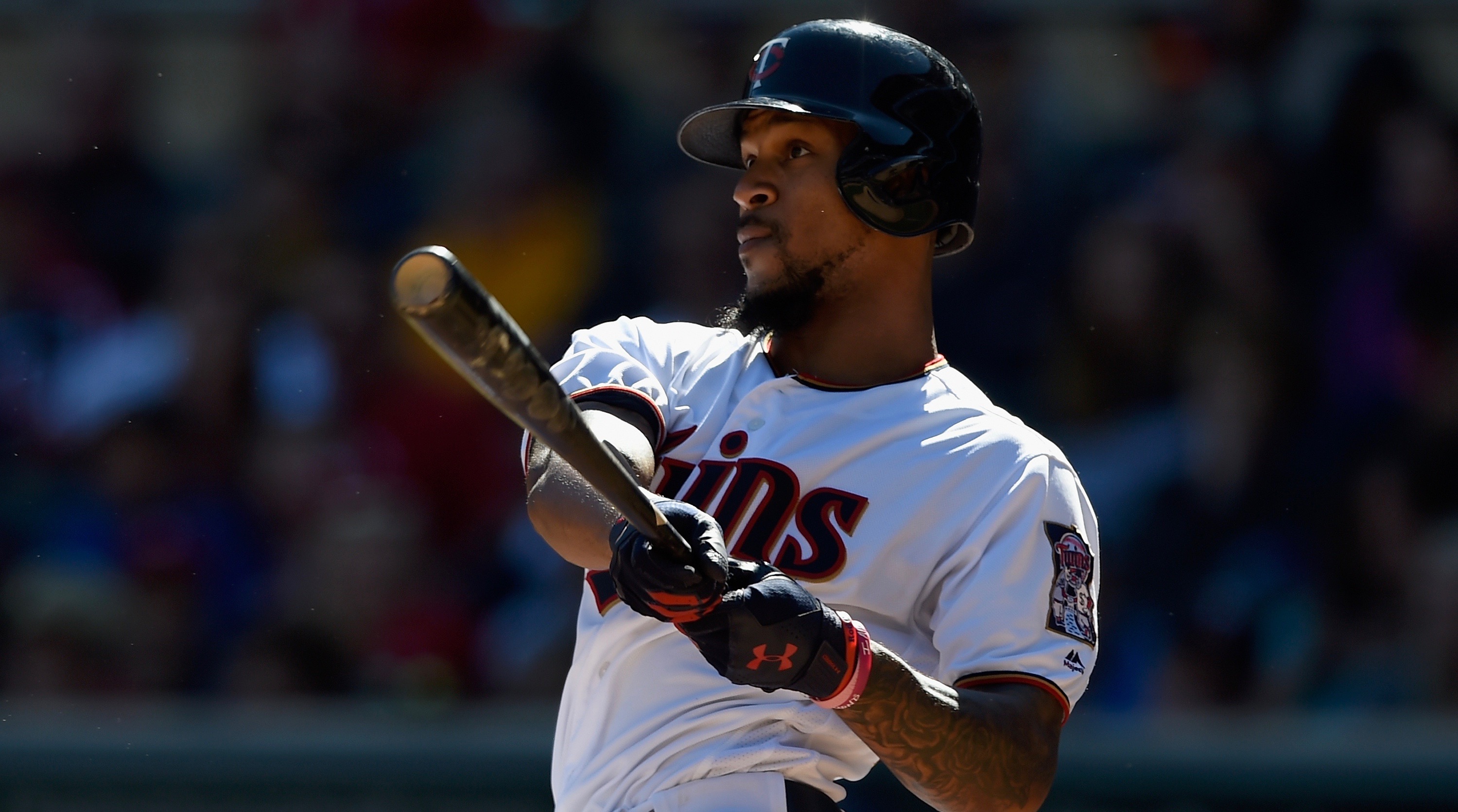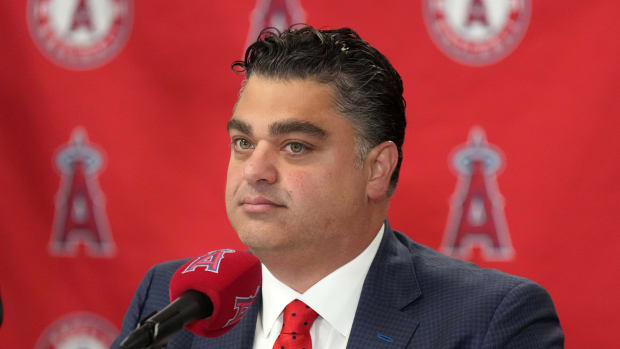
How Byron Buxton Shed a Crippling Slump To Help Push the Twins Toward the Playoffs
The numbers were nothing pretty; Byron Buxton knew that much. It was the last week of June, the Twins had just finished a series against the Red Sox, and Minnesota’s 23-year-old centerfielder had come up empty over and over again. In 11 at-bats in Boston, Buxton managed only one hit—an RBI single dunked into leftfield—and struck out four times, all swinging. The sorry showing dumped his season batting average below .200; the four whiffs brought him up to 80 in just 248 trips to the plate on the year. It seemed like the same sad story from last season: The former No. 1 prospect again looked overwhelmed by a game that he was supposed to be dominating.
Since making his major league debut two years earlier, Buxton had known nothing but struggle and failure, and as the pressure to perform built, his urge to tinker would increase. A change in his swing, a tweak to his mechanics, the addition and subtraction and then re-addition of a leg kick … Buxton cycled through potential solutions, picking up and discarding adjustments like a college freshman shopping classes. Yet nothing seemed to work. As a high school phenom, the sport had come easy. Now, he struggled to make sense of it. “You feel like you don’t know what you’re doing, especially when it happens day after day after day,” he says. “It’s very hard to try to find something good out of that.”
After a horrible first month of the season, Buxton and new Twins hitting coach James Rowson had started working on a series of changes to his stance and swing. As the weeks went by and the strikeouts piled up, it would have been easy to understand if Buxton had ditched the new mechanics and started from scratch once more. But as he talked things over with Rowson after that awful series at Fenway Park, there was no sense of panic or frustration. Those 11 at-bats may have resulted in just one measly single, but to Buxton, they were the beginning of something promising.
MLB Standings: Playoff, Wild-Card Races Plus Matchups If Season Ended Today
“I was like, J-Ro, something feels different,” he says. “I’m starting to feel what my legs are actually supposed to do and what the pitcher’s trying to do to me. The game just got so much slower for me. I started understanding what people were telling me about my swing. That’s when I really took off.”
“Took off” is an understatement. Since the beginning of July, Buxton is hitting a scalding .315/.365/.571 with 12 home runs in 225 plate appearances. His .939 OPS since the All-Star break, meanwhile, tops big-name sluggers like Kris Bryant, Eric Hosmer, Nelson Cruz and Gary Sanchez. And his huge second half is one of the top reasons why the Twins, coming off a 103-loss 2016 season and left for dead at the trade deadline, have surged into postseason contention as the second wild card.
“When I get in the batter’s box, I have amazing amounts of comfort and confidence,” Buxton says. “Anything close to the plate, I feel like I can get a hit.”
From the day he was drafted as the No. 2 pick in 2012 out of a small Georgia high school as a five-tool superstar, the Twins and baseball fans have been waiting for this moment: the breakout of Byron Buxton. The kid who hit .513 and stole 38 bases in 39 games as a senior, who in 2013 was the consensus top prospect in all of baseball at the age of 19, who reached the big leagues at 21 with so much hype piled on him that it was a wonder he could stand up straight … MLB had seen only flashes of that player. The Gold Glove-caliber defense has been there; so has the game-changing speed. But both have been buried beneath countless miserable at-bats full of confused, lost swings.
The transition to the majors for any player is tough enough, but most of them don’t carry the weight of a franchise on their shoulders. So it was for Buxton, tasked with bringing back to relevance a Twins team that hadn’t made the playoffs since 2009, hadn’t advanced past the first round since ’02, and hadn’t won a World Series since 1991, two years before he was born. Buxton was part of a youth movement that was supposed to form the core of the next Minnesota contender sooner rather than later, and the pressure for him to contribute right from day one was significant.
“Even though I would tell myself that the pressure doesn’t bother me, it’s still in the back of your head,” he says. “It spiraled downhill.”
Translating everything that had made him so good in high school and in the minors to the majors felt impossible. Buxton’s 2016 season lasted all of 17 games and 49 plate appearances in which he hit .156 and struck out 24 times before he was sent back down to Triple A in late April. When he was recalled at the end of May, he hit .204 over the next two months before being demoted again. Even when things were going well, he knew it wouldn’t last. Last September, he climbed out of his season-long slump by hitting .287/.357/.653 and homering nine times in 29 games. But his success was built on a hot streak that he couldn’t control or fully understand.
“Even though it was good, I still wouldn’t have been able to tell you what I was doing,” Buxton says. “I was hitting the ball and seeing the ball, but I wouldn’t have been able to tell you if I were using my legs or if my hands were in a certain spot.”
As expected, the strong September finish didn’t carry over into April, but it wasn’t just that the results weren’t there. Watch any of his early-season at-bats, and you’ll see a player struggling with every aspect of hitting. “He was spinning off the ball so badly, his recognition phase was almost nil, and the bat was in and out of the zone so quickly that he didn’t have a chance to hit anything that was away from him, especially if it was breaking away,” says manager Paul Molitor. Things got so bad in those first two months that he and the Twins’ front office discussed sending Buxton down to Triple A yet again.
Chris Sale's 300-Strikeout Season Places Him In Elite Company
“Part of the conversation I remember having with [general manager] Thad [Levine] and [chief baseball officer] Derek [Falvey] is how much can we beat this kid up here?” Molitor says. “He was still helping us win games—it was incredible the way he was able to separate the offense and defense. But as strong as he is mentally, eventually you’re going to reach a breaking point.”
As the team tried to figure out what to do with Buxton, he and Rowson worked on a fix. The first thing to go was his leg kick, which he had been using on and off since 2015: Rowson ditched it, hoping to create increased stability in Buxton’s lower half to allow him to drive the ball to all fields. He also had Buxton close his stance slightly, choke up more on the bat, and change his setup so his bat was down on his shoulders instead of pointing straight up, putting his hands more in sync with his hips and legs. “It allows him to put short, more accurate swings on the baseball,” Rowson says of the changes.
The numbers weren’t immediately there, but Molitor could tell something was different. “You could see that he’s not chasing that slider nearly as much, that he’s taking that fastball and hitting it to the right-center gap,” he says. “Just baby steps at first.” For Buxton, the changes helped slow the game down; for the first time in his major league career, he felt in charge of his at-bats. “I’ve got a feeling of what it’s supposed to be like and how it’s supposed to feel,” he says. “I can tell you with one pitch whether I was out front or was on my backside too long or didn’t get my hips through.”
Buxton has never struggled with any other aspect of his game. There are few if any players who can touch him with the glove: With every new Statcast number that charts outfield defense comes a leaderboard that always seems to have his name at the top. Likewise with his legs: He owns MLB’s top Sprint Speed at 30.2 feet per second, as well as the game’s fastest time from first to third on a triple—a blazing 10.52 seconds. Those skills have helped him stay moderately productive even despite his putrid offense. What’s truly scary to think about it is how good he can be if his breakout is for real. “He’d be a dangerous guy to put a ceiling on, because if you do, he’s probably going to go through it,” Rowson says.
There are many factors in the Twins’ sudden success: The development of hulking slugger Miguel Sano; the emergence of power-hitting outfielder Eddie Rosario; the maturation of hard-throwing righty Jose Berrios. But Minnesota’s success is always going to hinge most on Buxton, because his upside is so much higher than virtually everyone else in the game. He’s the nearly finished Death Star in Return of the Jedi, and he’s tantalizingly close to being fully armed and operational.
There will still likely be hiccups as Buxton develops: He entered Thursday’s action hitless in his last 10 at-bats with seven strikeouts as the Yankees unceremoniously swept the Twins in the Bronx. He’s likely to get a second chance at doing better in the House that Ruth Built if Minnesota can hold off the Angels for the second wild card and return to face New York in the wild-card game. But playoffs or not, there is hope that the real Byron Buxton has finally shown up—and now, he finally has the numbers on his side.



































